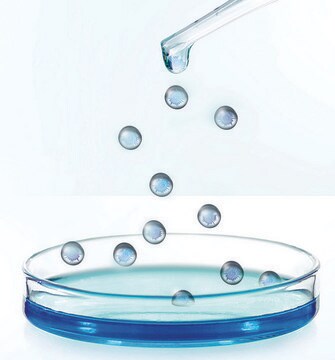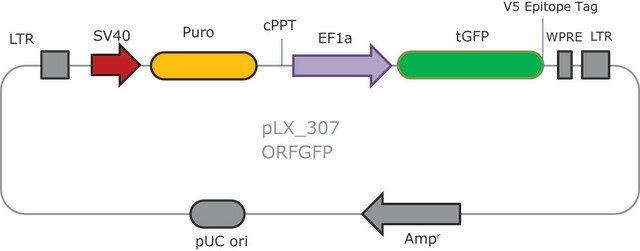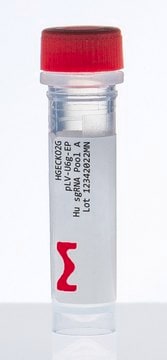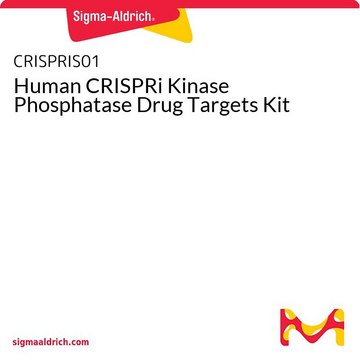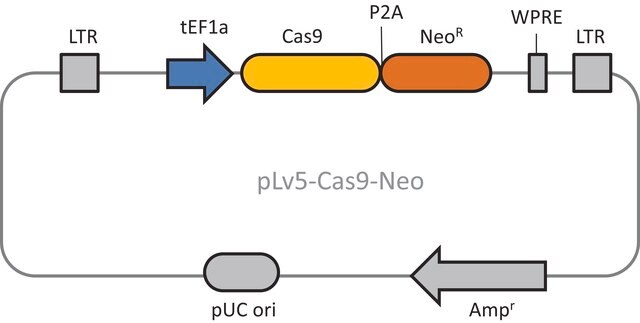Kluczowe dokumenty
HWGCRISPR
Sigma Whole Human Genome Lentiviral CRISPR Pool
About This Item
Polecane produkty
opakowanie
pkg of 8x25 μL (vials)
Poziom jakości
stężenie
5x108 VP/ml (via p24 assay)
Zastosowanie
CRISPR
Warunki transportu
dry ice
temp. przechowywania
−70°C
Powiązane kategorie
Opis ogólny
Zastosowanie
Działania biochem./fizjol.
Cechy i korzyści
- Use CRISPR nucleases to knockout protein-coding genes to assess their function
- Efficiently screen the whole human genome (16,000+ genes) at the bench-top without robotics or specialized equipment
- Increased flexibility consisting of 8 subpools at 23,000 clones per pool (184,000 clones total), from the previous 2 subpools (Gecko v2)
- Expanded gRNA coverage at 10 gRNAs per gene, from the previous 6 gRNAs per gene (Gecko v2)
- Numerous built-in enrichment and depletion controls allows researchers to confidently gauge the success of their pooled screening experiments
- 2 Vector System (pools are gRNA-only, Cas9 sold separately)
- Ease of optimization: Utilizes same vector system as Gecko v2 allowing for optimization one for both systems
- Minimize off-targeting: stringent gRNA design and tiling rules
Uwaga dotycząca przygotowania
Prior to performing a library-scale screening, two preliminary experiments must be conducted: (1) determine the sensitivity of target cell type to puromycin (kill curve), and (2) determine the functional titer of the lentivirus in your cell type by completing a colony-forming assay (measured in CFU/ml). The calculation of MOI (multiplicity of infection) should be based on the value of CFU. Different cell types vary in transduction efficiency and different lentiviral constructs do not behave identically, so it is critical to optimize your experimental conditions with control lentiviral CRISPR clones (available from Sigma) prior to performing your pooled experiment.
Inne uwagi
Informacje prawne
Kod klasy składowania
12 - Non Combustible Liquids
Klasa zagrożenia wodnego (WGK)
WGK 3
Temperatura zapłonu (°F)
Not applicable
Temperatura zapłonu (°C)
Not applicable
Wybierz jedną z najnowszych wersji:
Certyfikaty analizy (CoA)
It looks like we've run into a problem, but you can still download Certificates of Analysis from our Dokumenty section.
Proszę o kontakt, jeśli potrzebna jest pomoc Obsługa Klienta
Masz już ten produkt?
Dokumenty związane z niedawno zakupionymi produktami zostały zamieszczone w Bibliotece dokumentów.
Klienci oglądali również te produkty
Produkty
Our lentiviral vector systems are developed with enhanced safety features. Numerous precautions are in place in the design of our lentiviruses to prevent replication. Good handling practices are a must.
Systemy wektorów lentiwirusowych mają priorytetowe znaczenie dla bezpieczeństwa, a środki ostrożności zapobiegają replikacji. Dobre praktyki obsługi są niezbędne do użytkowania.
Successful targeting relies on optimizing key sensitive steps in the process, including lentiviral transduction. Below are some helpful handling and titration tips from our R&D lentiviral experts.
Uzyskaj wskazówki dotyczące obchodzenia się z lentiwirusami, optymalizacji konfiguracji eksperymentu, miareczkowania cząstek lentiwirusów i wyboru przydatnych produktów do transdukcji.
Protokoły
You are not alone designing successful CRISPR, RNAi, and ORF experiments. Sigma-Aldrich was the first company to commercially offer lentivirus versions of targeted genome modification technologies and has the expertise and commitment to support new generations of scientists.
FACS (Fluorescence-Activated Cell Sorting) provides a method for sorting a mixed population of cells into two or more groups, one cell at a time, based on the specific light scattering and fluorescence of each cell. This method provides fast, objective, and quantitative recording of fluorescent signals from individual cells.
Nasz zespół naukowców ma doświadczenie we wszystkich obszarach badań, w tym w naukach przyrodniczych, materiałoznawstwie, syntezie chemicznej, chromatografii, analityce i wielu innych dziedzinach.
Skontaktuj się z zespołem ds. pomocy technicznej
